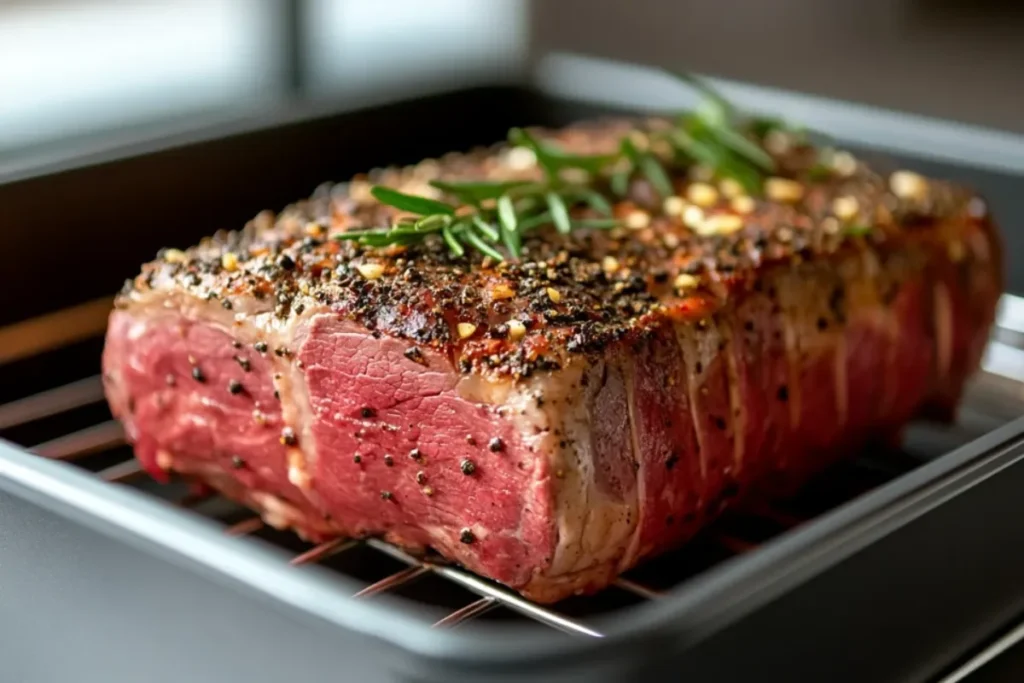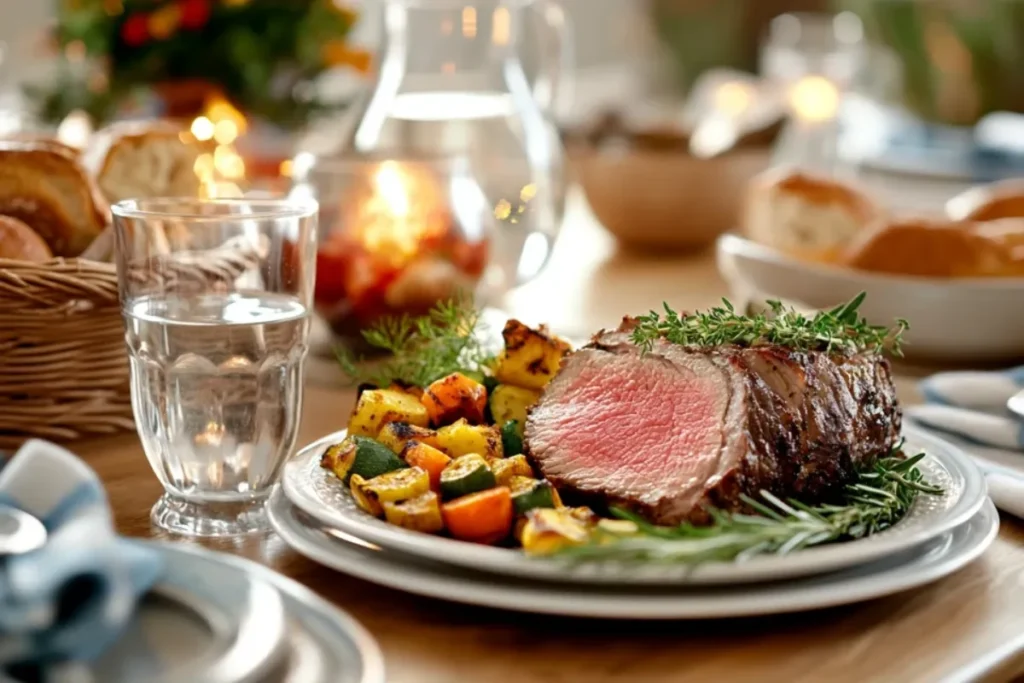When it comes to preparing prime rib, the techniques you use can make or break the final dish. From seasoning to cooking methods, each step contributes to the outcome. One method that often sparks debate is dredging—coating the meat with flour or another dry ingredient before cooking. So, does prime rib need dredging? This article explores the concept of dredging, its relevance to prime rib, and alternative methods to achieve the perfect roast.
Understanding Prime Rib and Dredging
What Is Prime Rib?
Prime rib, also known as a standing rib roast, is one of the most luxurious cuts of beef. It comes from the primal rib section of the cow, encompassing the ribeye and surrounding fat. Known for its rich marbling and tenderness, this cut is ideal for special occasions or holiday feasts.
- Definition and Characteristics: Prime rib boasts a juicy, flavorful interior with a tender texture. Its marbling ensures the meat stays moist and succulent, even after roasting. The standing rib roast is often cooked bone-in, which adds depth of flavor.
- Importance in Culinary Traditions: Prime rib has long been a centerpiece for celebrations. Its impressive size and delectable flavor make it a showstopper, often paired with complementary sides and sauces for a complete meal.
What Does Dredging Mean in Cooking?
Dredging is a cooking technique that involves coating food in a dry ingredient—typically flour, cornmeal, or breadcrumbs—before cooking. This method is commonly used for frying but can also enhance crust formation in roasting.
- Explanation of the Dredging Process: To dredge, you simply dip the food item into the dry coating, ensuring an even layer. This technique helps seal in moisture, creates a crispy outer layer, and sometimes improves seasoning adherence.
- Common Foods That Are Dredged: Fried chicken, fish fillets, and even some roasted meats like pork chops often benefit from dredging. However, its application to prime rib is less common and remains a topic of debate.
Understanding both the fundamentals of prime rib and the purpose of dredging sets the stage for evaluating whether prime rib needs dredging or if other methods yield better results. In Part 2, we’ll explore traditional ways to prepare prime rib without dredging.
Traditional Prime Rib Preparation Methods
When preparing prime rib, achieving a tender, flavorful roast with a delectable crust is the ultimate goal. Traditional methods focus on seasoning and cooking techniques that enhance the meat’s natural qualities without the need for dredging.

Seasoning Techniques
- Dry Brining: Applying a dry brine involves rubbing the prime rib with a mixture of salt, sugar, and spices, then refrigerating it uncovered for several days. This process enhances flavor and tenderness by allowing the seasoning to penetrate deeply into the meat. citeturn0search0
- Herb and Spice Rubs: Creating a paste with fresh herbs, garlic, and olive oil to coat the roast adds aromatic flavors. Common herbs include rosemary, thyme, and sage, which complement the rich taste of prime rib.
Cooking Methods
- Oven Roasting: This classic method involves searing the roast at a high temperature to develop a crust, then reducing the heat to cook the meat evenly. For instance, starting at 450°F for 15 minutes, then lowering to 325°F until the desired internal temperature is reached. citeturn0search16
- Reverse Searing: In this technique, the prime rib is cooked slowly at a low temperature until nearly done, then seared at high heat just before serving. This approach ensures even cooking and a flavorful crust without overcooking the interior. citeturn0search8
- Closed Oven Method: Here, the roast is placed in a preheated oven at a high temperature, then the oven is turned off, allowing the residual heat to cook the meat slowly. This method requires precise timing and should be done without opening the oven door during the cooking process. citeturn0search5
Achieving the Desired Crust
- High-Temperature Searing: Searing the roast at a high temperature, either at the beginning or end of cooking, caramelizes the exterior, creating a flavorful crust. This step is crucial for texture and taste.
- Basting: Occasionally spooning pan juices or melted butter over the roast during cooking can enhance the crust’s flavor and help keep the meat moist.
These traditional methods focus on enhancing the prime rib’s natural flavors and textures without the need for dredging. By employing proper seasoning and cooking techniques, you can achieve a succulent roast with a satisfying crust.
For more delicious recipes, check out our Prime Rib Roast article.
The Role of Dredging in Cooking
Dredging is a culinary technique that involves coating food with a dry ingredient, such as flour or breadcrumbs, before cooking. This method is commonly used to achieve a crispy exterior in fried or sautéed dishes.
Purpose of Dredging
- Moisture Retention: Dredging helps seal in moisture, preventing the food from drying out during cooking.
- Enhanced Browning: The dry coating promotes the Maillard reaction, leading to a desirable golden-brown crust.
- Improved Texture: It adds a pleasant crunch or crispness to the exterior of the food.
Common Applications
- Fried Foods: Items like fried chicken, fish fillets, and cutlets are often dredged to create a crispy coating.
- Sautéed Dishes: Thin cuts of meat, such as veal or chicken piccata, are dredged in flour before sautéing to achieve a light crust.
Dredging and Prime Rib
Applying dredging to prime rib is unconventional and not typically recommended. The flour coating may interfere with the development of the natural crust that forms during roasting. Traditional methods, such as dry brining and high-temperature searing, are preferred for achieving the desired texture and flavor in prime rib.
In summary, while dredging is effective for certain dishes to enhance texture and moisture retention, it is not a standard practice for preparing prime rib. Traditional seasoning and roasting techniques are more suitable for this premium cut of meat.
Pros and Cons of Dredging Prime Rib
Dredging has its place in culinary techniques, but when it comes to prime rib, the benefits and drawbacks deserve careful consideration. Let’s evaluate whether prime rib needs dredging.
Pros of Dredging Prime Rib
- Enhanced Crust Formation: Dredging can create a thicker crust, potentially locking in juices and adding a unique texture to the exterior. For those who enjoy a crispy outer layer, dredging may seem appealing.
- Flavor Retention: Coating the meat with a seasoned flour mixture could trap additional flavors and help them adhere during cooking. This might be beneficial in high-heat cooking methods like broiling.
- Aesthetic Appeal: Some chefs argue that dredged roasts develop a visually appealing, golden-brown crust that looks enticing when served.
Cons of Dredging Prime Rib
- Interference with Natural Crust: Prime rib naturally forms a flavorful crust during roasting, thanks to its fat content and seasoning. Adding a flour coating might detract from this traditional texture.
- Risk of Burnt Flour: During longer roasting times, the flour can burn, resulting in a bitter taste that overwhelms the dish.
- Unconventional Technique: Unlike fried foods, prime rib is traditionally celebrated for its uncoated exterior. Dredging is not a standard practice and might be off-putting to purists.
In the end, whether or not to dredge prime rib comes down to personal preference. However, traditional methods are widely regarded as more effective in highlighting the meat’s natural flavors and textures. For tips on achieving a perfect roast without dredging, check out our Ultimate Prime Rib Recipe.
Alternatives to Dredging Prime Rib
For those asking, “Does prime rib need dredging?”, the answer often points to better alternatives. Traditional techniques can deliver the same benefits—crust, flavor, and moisture retention—without the potential downsides of dredging.
Dry Brining for Deeper Flavor
- How It Works: Dry brining involves coating the prime rib with salt and optional spices, then letting it rest uncovered in the refrigerator for 24-48 hours. This process allows the salt to penetrate the meat, enhancing both flavor and tenderness.
- Advantages Over Dredging: Unlike flour, which sits on the surface, salt in a dry brine draws out moisture that then reabsorbs into the meat. This creates a deep, savory flavor and improves texture.
High-Temperature Searing for a Perfect Crust
- Achieving a Crispy Exterior: Searing the roast at a high temperature—either at the beginning or end of cooking—creates a caramelized crust. This method, called the Maillard reaction, enhances flavor without the risk of burnt flour.
- Best Techniques: Use a preheated oven or stovetop to sear all sides of the roast before placing it in the oven to finish cooking. Alternatively, reverse searing at the end locks in juiciness while creating a perfect crust.
Herb and Spice Rubs
- Infusing Flavor: Create a paste using fresh herbs like rosemary, thyme, and garlic, combined with olive oil. Coat the roast generously before cooking to impart an aromatic flavor.
- Why It’s Better: Herb rubs stick to the meat without the need for flour, allowing the prime rib’s natural crust to develop fully during roasting.
Basting for Extra Moisture
- Using Pan Juices: During roasting, spooning pan drippings over the prime rib ensures it stays moist and flavorful. Add butter, garlic, or fresh herbs to the drippings for added depth.
- No Need for Coatings: Basting achieves many of the same goals as dredging—moisture retention and enhanced crust—without adding unnecessary ingredients.
By choosing alternatives like dry brining, high-temperature searing, and herb rubs, you can prepare a prime rib that showcases its natural beauty and flavor. For more tips on perfecting your prime rib, visit Your Recipes.
Expert Opinions on Dredging Prime Rib
When answering the question, “Does prime rib need dredging?”, consulting expert opinions is essential. Chefs, butchers, and food enthusiasts often share insights that can help you decide whether dredging is worth trying.
What Chefs Say About Dredging Prime Rib
- A Focus on Natural Crusts: Most chefs agree that prime rib naturally develops a rich, flavorful crust through proper seasoning and roasting techniques. Chef Julia Hart, a culinary instructor, states, “Adding flour through dredging can mask the natural flavors and marbling of prime rib.”
- Emphasis on Traditional Methods: Renowned chef Marcus Lane believes dredging isn’t necessary for prime rib. He recommends dry brining and reverse searing as the best ways to create an even crust while preserving the meat’s natural taste and texture.
Insights from Home Cooks and Enthusiasts
- Mixed Reviews on Dredging: Some home cooks experiment with dredging and report mixed results. While a few enjoy the thicker crust it creates, others find that the flour burns during the roasting process, leaving a bitter aftertaste.
- Preference for Simplicity: Many enthusiasts opt for simplicity when preparing prime rib. “The beauty of prime rib lies in its rich marbling and the ease of preparation,” says Megan Ortiz, a food blogger. “Dredging complicates the process without adding significant benefits.”
Taking advice from experts and experienced cooks can help clarify whether dredging fits your cooking style and preferences. For most, traditional techniques provide better outcomes.

Frequently Asked Questions About Prime Rib Dredging
Prime rib preparation raises a lot of questions, especially when it comes to less common methods like dredging. Let’s address some FAQs to demystify the process.
Does Prime Rib Need Dredging for a Good Crust?
No, prime rib does not need dredging to achieve a great crust. The meat’s natural fat, combined with high-temperature cooking, creates a flavorful, golden-brown crust. Techniques like dry brining and searing are more effective and widely recommended.
Can Dredging Enhance the Flavor of Prime Rib?
While dredging might add a slight flavor boost if combined with seasoned flour, it’s generally unnecessary. Prime rib’s flavor comes from its marbling and proper seasoning. Overcomplicating with flour can distract from the roast’s natural taste.
Is Dredging Suitable for All Prime Rib Cooking Methods?
Not really. Dredging is more common in frying or pan-searing methods. For oven-roasted prime rib, dredging can result in uneven cooking and may not withstand the long roasting times without burning.
What Are the Best Alternatives to Dredging?
Dry brining, herb rubs, and reverse searing are excellent alternatives. These methods enhance the flavor and texture without the potential downsides of dredging. They also align with traditional prime rib preparation techniques.
By addressing these common questions, it’s clear that dredging isn’t a necessity for preparing prime rib. Instead, using tried-and-true techniques will help you achieve a succulent, flavorful roast that shines on its own. For more prime rib tips and recipes, check out Your Recipes.
Comparing Dredging with Other Prime Rib Preparation Methods
When debating does prime rib need dredging, it’s helpful to compare dredging with other popular preparation methods. This side-by-side comparison highlights the strengths and weaknesses of each approach.
Dredging vs. Dry Brining
- Flavor Development: Dry brining penetrates the meat with salt and spices, enhancing flavor from the inside out. In contrast, dredging only impacts the surface, offering limited seasoning potential.
- Crust Formation: While dredging creates a thicker, flour-based crust, dry brining relies on the natural fat and seasoning of the prime rib to develop a flavorful and authentic crust.
- Ease of Execution: Dry brining is simpler and less messy, making it a preferred choice for most cooks. Dredging requires additional steps and can complicate cleanup, especially if the flour burns during roasting.
Herb and Spice Rubs VS Dredging .
- Aromatic Additions: Herb and spice rubs bring a fresh, aromatic element to prime rib. Dredging, on the other hand, lacks the depth and complexity of flavor offered by fresh herbs like rosemary or thyme.
- Texture Contrast: A rub integrates into the natural crust of the meat, while a dredge creates a more pronounced barrier. For prime rib, many find that a rub complements the roast’s natural qualities better.
- Versatility: Spice rubs can be customized to suit different flavor profiles, whereas dredging is more uniform and limits creative expression.
Dredging vs. High-Temperature Searing
- Crust Quality: High-temperature searing produces a caramelized crust that’s hard to beat. Dredging, while effective for frying, struggles to replicate this effect in a roasting context.
- Cooking Time and Efficiency: Searing quickly locks in juices and enhances texture, whereas dredging can add unnecessary steps without guaranteeing better results.
By comparing these methods, it’s clear that dredging is rarely the first choice for prime rib. Traditional techniques deliver better results and enhance the natural flavor and texture of this premium cut.
Conclusion and Final Thoughts
So, does prime rib need dredging? The simple answer is no. While dredging has its place in certain culinary applications, it’s not essential for preparing a perfect prime rib. Traditional methods like dry brining, herb rubs, and high-temperature searing provide more consistent results and preserve the roast’s natural appeal.
Prime rib is celebrated for its rich marbling, tender texture, and bold flavor. Dredging may interfere with these qualities by adding an unnecessary coating that can mask the meat’s true character. Moreover, the risks of burning flour or complicating preparation make dredging an impractical choice.
Instead, focus on time-tested techniques. A well-seasoned prime rib, slow-roasted to perfection, with a natural crust developed through searing or basting, will always outshine any dish that relies on dredging. These methods bring out the best in the cut, ensuring a tender, flavorful roast that’s as impressive to serve as it is to eat.
Ultimately, the key to a great prime rib lies in simplicity and respect for the ingredients. By mastering straightforward techniques, you can create a centerpiece that delights your guests and makes any occasion special.
For more prime rib recipes and preparation tips, visit Your Recipes. Whether you’re hosting a holiday feast or just enjoying a special meal, you’ll find inspiration and guidance to elevate your cooking game.
For more delicious recipes, check out our Prime Rib Roast article.
